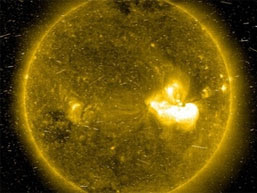Source: Yahoo!7 News
March 15, 2012, 11:28 am
A NASA video of a dark, disc shaped object hovering near the sun has set off a wave of speculation online as amateur astronomers try to figure out what the object could be.
The video, taken from a NASA satellite and uploaded to Youtube by a man calling himself SunsFlare, shows a huge round object floating near the sun, with a large 'twister tail' extending from it.
The video shows the sun's rays bursting out from the surface, but a large circular object remains black, with a dark 'twister tail' remaining connected to the sun.
"I have no idea what it is", SunsFlare says, "There's something in the plasma field that would definitely be affected by the [burst of energy]."
Over 380,000 people have viewed the video in the few days since it was uploaded.
However NASA says it has an explanation for the anomaly.
It's not the Deathstar, another planet being born or a UFO full of little green men as some viewers suspected.
It's simply a filament, or prominence.
NASA says a filament is a "large, bright feature extending outward from the Sun's surface. [Filaments] are anchored to the Sun's surface in the photosphere, and extend outwards into the Sun's hot outer atmosphere, called the corona."
But NASA can't explain why the object is cooler than the energy around it, and therefore remains dark when viewed from NASA’s telescope.
A NASA astrophysicist says the image is completely normal.
"Filaments appear to be dark because they're cooler in relation to what's in the background. When you look at it from the edge of the sun, what you see is this spherical object and you're actually looking down the tunnel."
NASA says it is rare for a prominence to form as such a distinct shape however.
Generally, a prominence comes in the form of a violent outburst, rather than the sphere seen in the video above.
March 15, 2012, 11:28 am
A NASA video of a dark, disc shaped object hovering near the sun has set off a wave of speculation online as amateur astronomers try to figure out what the object could be.
The video, taken from a NASA satellite and uploaded to Youtube by a man calling himself SunsFlare, shows a huge round object floating near the sun, with a large 'twister tail' extending from it.
The video shows the sun's rays bursting out from the surface, but a large circular object remains black, with a dark 'twister tail' remaining connected to the sun.
"I have no idea what it is", SunsFlare says, "There's something in the plasma field that would definitely be affected by the [burst of energy]."
Over 380,000 people have viewed the video in the few days since it was uploaded.
Is it the Deathstar?
A NASA video of a dark, disc shaped object hovering near the sun has set off a wave of speculation online.However NASA says it has an explanation for the anomaly.
It's not the Deathstar, another planet being born or a UFO full of little green men as some viewers suspected.
It's simply a filament, or prominence.
NASA says a filament is a "large, bright feature extending outward from the Sun's surface. [Filaments] are anchored to the Sun's surface in the photosphere, and extend outwards into the Sun's hot outer atmosphere, called the corona."
But NASA can't explain why the object is cooler than the energy around it, and therefore remains dark when viewed from NASA’s telescope.
A NASA astrophysicist says the image is completely normal.
"Filaments appear to be dark because they're cooler in relation to what's in the background. When you look at it from the edge of the sun, what you see is this spherical object and you're actually looking down the tunnel."
NASA says it is rare for a prominence to form as such a distinct shape however.
Generally, a prominence comes in the form of a violent outburst, rather than the sphere seen in the video above.






